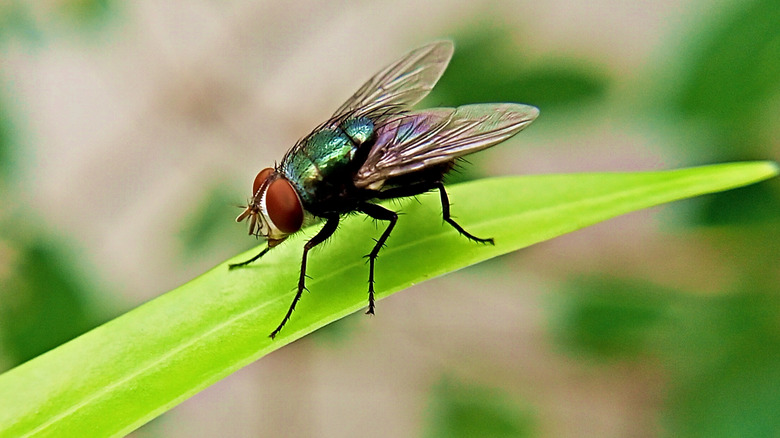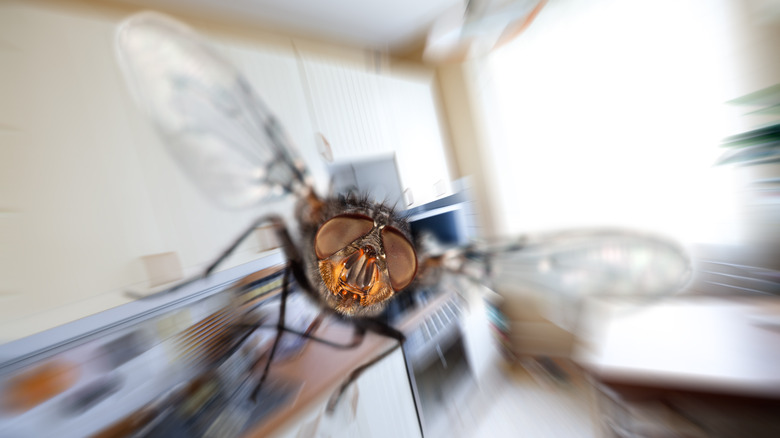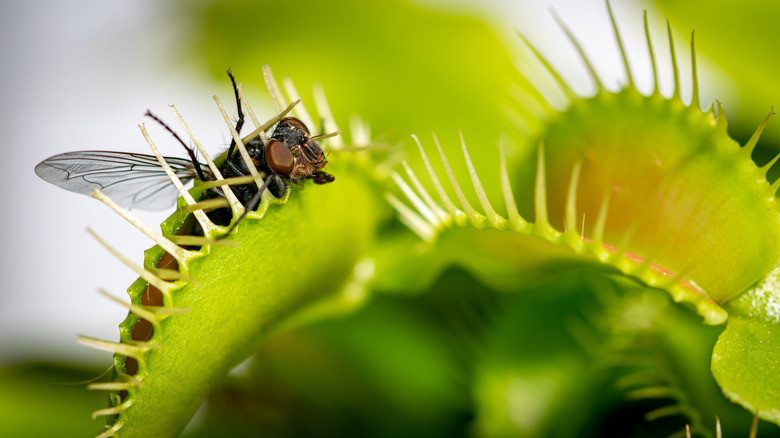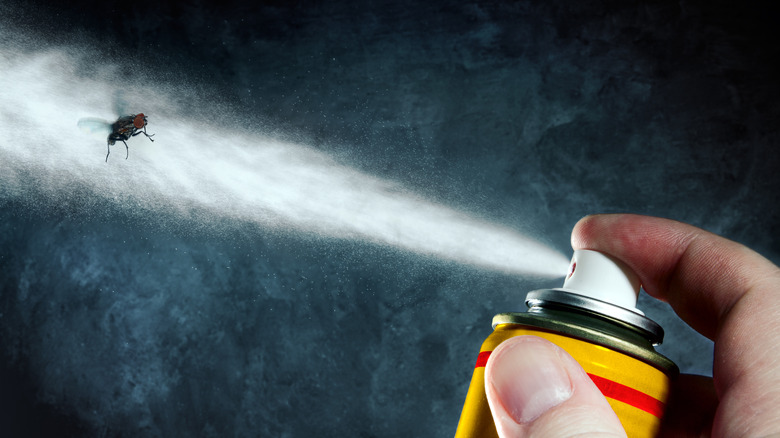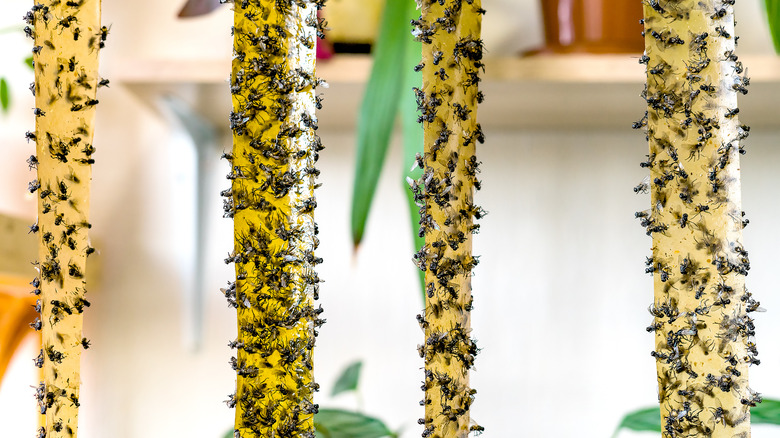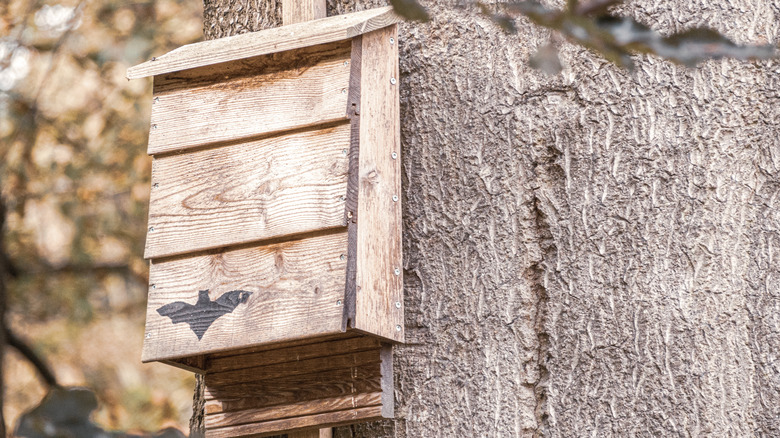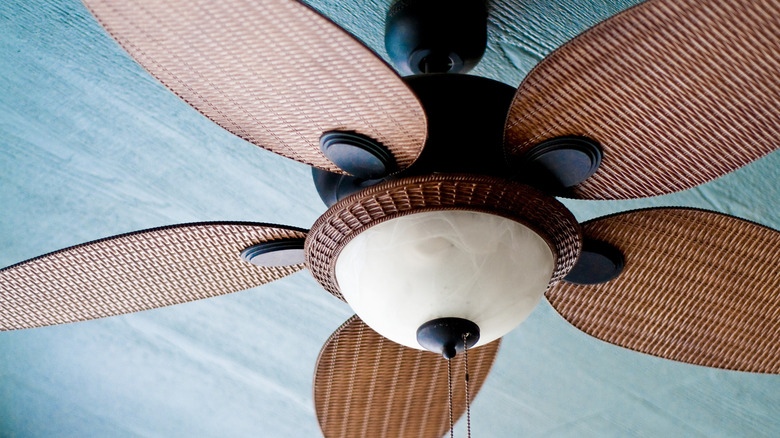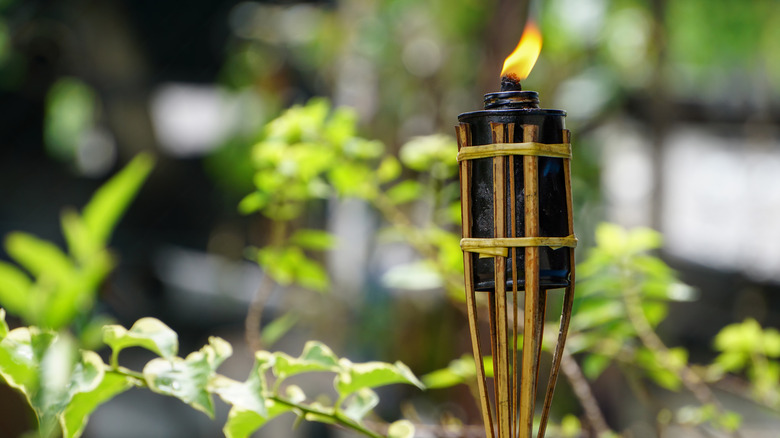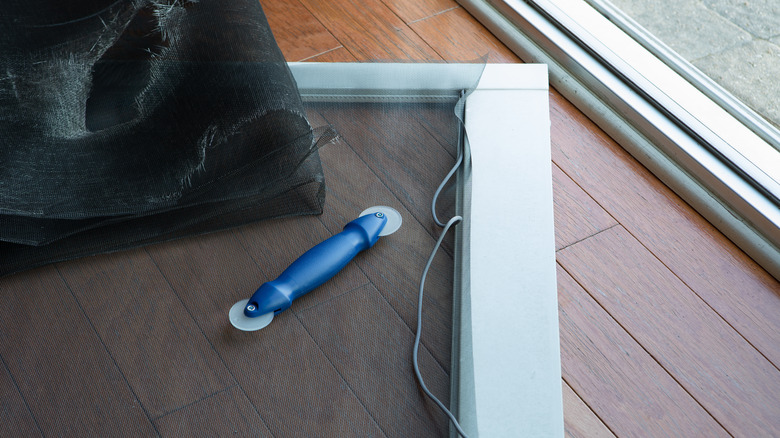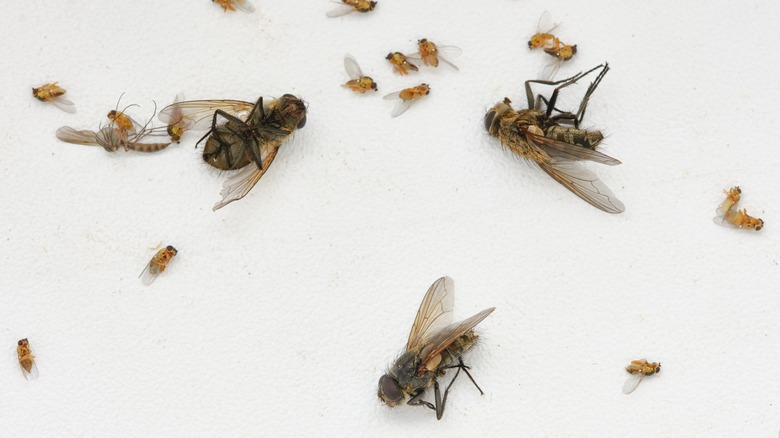13 Best Ways To Get Rid Of Flies
We may receive a commission on purchases made from links.
We've all been there at some point or another: faced with a house full of those pesky flies that buzz around your head and land on all your (previously) cleaned surfaces. Flies are a problem through all four seasons as they never stop reproducing, but many people notice that they get worse in the summer; this is because the heat causes them to be more active, notes Service Master. While flies aren't necessarily difficult to get rid of, you will need to be diligent and consistent in your efforts to do so as they much prefer to live in your house where food is likely plentiful rather than return to the outdoors.
The longer you wait, the more likely the flies will reproduce, dropping hundreds of eggs within the course of their super-short lifetimes (via Country Living) — which will only complicate your unfortunate problem. Additionally, given this insect's inclination to feed off dead and decaying things — animal carcasses, feces, garbage, and open wounds and sores — the more time they spend in your home, the more exposed you are to potential diseases and other nasty particles.
The good news is that there are ways you can get rid of flies once and for all, whether it's one fly that squeezed its way in as you walked into your house from the garden or a group of them that you can't seem to shoo back outside, or even an all-out infestation. Keep reading for some ideas to try out.
1. Get rid of everything that attracts flies
Flies are nasty little critters that love anything with a pungent scent, whether good or bad. This means they are just as attracted to your overflowing garbage that you've been meaning to dispose of for the past two days as they are to a bit of spilled juice from breakfast that you haven't gotten around to cleaning up. If you have a fly problem, now is not the time to procrastinate. You'll need to be diligent in getting rid of or hiding any potential food source that can draw flies into your home, advises Country Living.
First, make sure you run your garbage disposal thoroughly every time you dump food down your sink, properly dispose of food scraps, and place half-filled sugary drinks in the fridge when not in use. Clean out your cat's litter box or baby's diaper pail more often to ensure feces and urine don't linger for too long in your home, and make sure you disinfect any receptacle that holds food or waste of any kind, including your trash and recycling bin, compost bin, etc., on a regular basis to thoroughly remove lingering scents.
Remember that flies are entering your house from the outdoors, meaning that if there are similar issues going on in your yard or along the exterior of your home (decaying leaves, pet fecal matter, etc.), you'll need to regularly remove all sources of stink to minimize the likelihood that they'll sneak into your home.
2. Use light traps
A fly trap, or insect light trap, is a common form of pest control that's often used in industrial spaces to kill flies in large quantities. However, it's a great option for home environments as well. The way the traps work is by emitting UV light rays that draw the flies in, according to Terminix. When the flies land on the trap, a fatal electric shock is emitted that kills them instantly. Many light traps also include a tray at the bottom so you don't end up with electrocuted flies all over your floor. You can find light traps in a number of different places, including superstores, home improvement stores, pest service companies, and online. All you need are a simple set of tools for securing your light trap to the wall and an outlet to plug it in.
There are several different types of light traps that you can consider if you'd like to try this method. A wall mount is installed at the traveling height of most flies, around three to five feet from the ground, and is situated next to windows and doors. A freestanding light trap is great for those needing transportability as it can easily be moved from room to room and placed on counters and other surfaces. If you're worried about light traps being an eyesore in your house, you might consider a wall sconce, which functions identically to a wall mount, but is aesthetically designed.
3. Trap flies with vinegar and dish soap
One popular DIY method to get rid of flies utilizes a mixture of vinegar and dish soap, per Happy Money Saver. You'll also be pleased to know that you can set up this fly trap in minutes. To make the trap, gather apple cider vinegar, liquid dish soap, a toothpick, string, a small jar or cup, and plastic wrap. You'll start by splashing a bit of apple cider vinegar into your container of choice until you have about two finger widths of liquid settled at the bottom. Next, you'll squeeze in a small amount of dish soap and stir. The plastic wrap should cover the container while the string will secure it tightly. With the toothpick, go to town stabbing holes in the plastic, but keep in mind that they should be big enough for a fly to drop in without much effort. Make it easier for flies to find the potent-smelling mixture by leaving it in a central location and then watch the magic happen.
Once you've caught some of those pesky flies, you're probably wondering why this is such a genius fly-trapping method. In a nutshell, the flies are attracted to the scent of the apple cider vinegar. When they drop into the container to slurp up its contents, they find themselves sinking to the bottom, unable to get back out. This is where the dish soap works its trick, eliminating the surface tension of the liquid and drowning the poor critters.
4. Use Venus fly traps
True to their name, the Venus flytrap is one of nature's best defenses against flies. This carnivorous plant catches and eats flies that have the misfortune of entering its traps. If you're wondering how a plant manages to catch and eat flies, it's actually quite genius: The Venus flytrap releases a sweet-smelling secretion along its leaf traps that attracts flies, according to SFGate. The mechanisms that allow the traps to snap shut are triggered when a fly rubs up against hairs lining the leaves. A chemical message is sent to the trap's cells that instruct them to enlarge, the result of which forces the traps closed.
To make matters worse, the more the fly fights to escape the trap, the tighter the trap constricts, keeping it prisoner. In order for the plant to digest the fly, which takes place over five to 12 days, it must create a seal that prevents air from getting into the traps, as per Healthline. Then the digestive juices flow freely to break down the fly and supply nutrients to the plant. At the end of the process, the plant expels the insect's exoskeleton.
If you're interested in this natural fly trap, plant them outside the entrances to your home. You can also keep one inside your home for any flies that still make their way in, but keep in mind that you will need to supply the plant with flies if none show up on their own.
5. Kill flies with insecticide
Insecticides for indoor use are a widely used option for getting rid of flies. Regardless of the number of flies that have infested your home, insecticides are efficient and effective at killing them. When it comes to insecticides, the type you choose will depend on where you spray it. There are indoor formulas that are safe in homes with pets and children while outdoor insecticides may be more harmful and toxic. Keep in mind that while insecticides are a common choice, they are not the most long-lasting or resistant methods for fly control. Insecticides break down quickly, requiring many reapplications over a short period of time, and flies often build up a natural immunity to them, reports Healthline.
If you choose to use an insecticide for short-term pest control, make sure to follow the manufacturer instructions closely to apply it in the necessary places in your home and use the correct amount. As a general rule, you'll want to be able to see the moisture from the insecticide without saturating your floor (via Do-It-Yourself Pest Control). Certain aerosols can be sprayed directly on a fly or fly population to kill them instantly in the case of a large infestation. Regardless of which insecticide you choose, make sure you have a broom and dustpan (or vacuum) handy to clean up the dead flies that you'll find throughout your house, and disinfectant to clean the floors and surfaces where they fall.
6. Catch flies with sticky traps
Sticky traps consist of a long, bright paper strip covered in a sticky glue surface that prevents flies from escaping once they've landed, as noted by Spalding Labs. Some sticky traps also emit odors that are designed to attract flies. This method of fly control is versatile and generally long-lasting, although traps need to be replaced when they're full or lose their stickiness, whichever comes first. Sticky traps are safe for pets, children, and humans, making them a great option for indoor use.
When installing sticky traps in your home or outdoor space, they should hang at the distance that flies travel — typically three to five feet above the ground. Since flies prefer hanging out on elevated surfaces, you can also place a few higher up towards the ceiling. The long strips of tape should also be hung in light places where flies will see them as they are attracted to the bright color — typically yellow. For example, placing a sticky trap in a closet or pantry will not be as effective at clearing your house of flies as hanging it in an open, light-filled space in plain view.
One potential downside to this method is that sticky traps are not aesthetically pleasing and can be a bit gross to look at it once they are full of flies. However, if you have a temporary fly problem, the short-lasting eyesore may be worth it to you.
7. Deter them with fly-repellant herbs and plants
There are many herbs and plants that naturally repel flies, making them a fantastic choice to plant in your garden or inside your home, says Gardening Know How. The best part about using herbs to keep flies away is that you can also use their leaves and parts to make delicious meals or keep your house smelling nice with their strong aromas. Basil is one herb that is known for its excellence at staving off flies and one that thrives inside or outside with lots of light. Crushing the leaves and applying them to your skin and clothes also works as a natural fly (and other insect) repellant. Tansy herb is similar in appearance to the marigold flower and can be planted inside or outside your home. Bay leaf, gray-green in color, wards off flies and adds deep flavor when used in cooking. Lavender is just one more example of an herb you'll want to add to your home to keep flies away and benefit from its lovely scent.
You can keep any of the above herbs on hand in several ways to ensure you always have a natural fly repellant in your home. All of them can be grown fresh in containers, made into essential oils that you can wear on your skin once properly diluted, dried and placed in breathable bags throughout your house, or distributed throughout your home or on your clothes via a spray bottle.
8. Make a soda bottle trap
This final hack is a brilliant DIY fly trap that you probably already have on hand; you'll need just one two-liter plastic soda bottle. Once you set up the trap, you'll have flies coming from all corners of your house to unknowingly face their demise. The soda bottle trap can be emptied and reset on a regular basis, making it a long-lasting solution to fly invasions.
To make the trap, drink the bottle's contents and then rinse it out. With a pair of scissors, chop off the top third of the bottle where the label ends, directs Yahoo!. The part that will attract flies to your trap is taken care of next: juice, sugar water, or another sweet-smelling drink should fill the bottom third of the bottle (up to where the bottom edge of the label ends). Now you're ready to invert the top part that you cut off and seal into the rest of the bottle with tape or glue. Make sure you leave the cap off when you do this.
Flies will enter the trap through the open hole in search of the sweet scent, but won't have much luck getting back out. After several minutes, they will drown in the liquid, which you can empty as often as you see fit. If you find that the trap isn't attracting as many flies as you'd like, make it even more appealing by adding some old food scraps, such as meat.
9. Welcome their natural predators to your yard
According to the United States Geological Survey (USGS), many species of bats survive solely by eating insects, and they feast on an impressive number, given their small size. Welcome bats to your yard to reduce the population of flies as well as other insects. Make your yard hospitable to bats by adding a water feature like a bird bath or small fountain (via World Birds). A three-chambered bat box is another great way to draw these predators to your yard. They also love night-blooming flowers, so plant blooms like moonflowers and yucca for pretty bat attractors.
You can also attract birds like swifts, swallows, and house martins to your yard for help (via Home & Roost). These birds hunt and eat flying insects as they soar through the air. Fill your feeders with seed mixes designed to attract these specific breeds. These birds tend to nest on outbuildings and in dark eaves; leave their homes undisturbed so they can continue fly hunting in your yard (via In The Garden OnIine).
10. Turn on the fans
According to How Things Fly, house flies and other flying insects are affected by strong winds. On a windy day, they are slower flyers and are often forced to fly in the direction of the wind. Use this natural occurrence to your advantage and simulate windy conditions in your home. Turn your ceiling fans on high and place oscillating fans near windows or doorways to force flies to exit.
You can also add fans to your outdoor areas for the same impact. Look for fans rated for outdoor use with large blades that will produce stronger winds (via Modern Fan Outlet). Then, install them in outdoor living spaces like covered porches and pergolas. When serving food outside, set a portable fan near the table to keep flies at bay. You can also set up a misting fan as a bug-deterrent with additional cooling power (via USA Today).
11. Burn citronella candles and use citronella sprays
According to Insect Cop, citronella grass is a natural plant that repels flies. Its scent can prevent flies from hanging around your home or yard. These plants love sunlight so plant them in pots on your sunny patio or in a well-lit area of your yard. You can also strategically place them on window sills to discourage flies from entering your home. Mint and lemongrass can also deter flies, so consider adding them to your citronella grass containers for an extra boost.
For a more low-maintenance approach, you can use citronella torches, candles, or sprays for the same effect (via Wildlife Informer). These products are made from the citronella plant's oils and are non-toxic to humans. Candles and torches come in various colors, sizes, and shapes to blend with your outdoor decor. And citronella spray is an awesome alternative for people allergic to DEET, a common bug spray ingredient. Plus, these items are so common that you can easily purchase them for a reasonable price.
12. Fix any ripped window screens and seal any gaps
Flies can squeeze through remarkably small gaps to enter your home. The University of Missouri recommends using 14 to 16-mesh screens to keep flies at bay. Make sure the screens fit the frames tightly and that there are no tears or gaps. If you find a small tear in your screen, you can use a mesh patch to cover the hole (via The Home Depot). However, if you find that your entire screen needs to be replaced, you can purchase a roll of replacement screens to use in your existing frame. This is a great opportunity to switch to a finer mesh. Cut the new screen to overlap the edges of the frame and use a spline roller to push it securely into the frame's grooves.
You should also routinely check the seals around doors and windows for any gaps that could allow flies or any other critters to enter your home. Adding weather-stripping and a door sweep to your doors can seal them and prevent flies from entering (via Mantis Pest Solutions). To seal window frames, purchase outdoor-rated caulk and a caulking gun (via wikiHow). On a dry day, remove any damaged caulk and replace the strip with a continuous flow of new caulking to guarantee a bug-tight seal.
13. Call the pros
If you feel like you're constantly dealing with flies entering your home or think you might have a significant infestation, it's time to call the professionals for help. Sciencing points out some tell-tale signs that you have a substantial fly infestation in your home. Check places where the insects frequent, like trash cans, for large quantities of dead flies. The pests are also attracted to light and water, so check wet and bright places like light fixtures and gutters for signs of infestation. These insects can carry diseases, so it's important to have professional pest controllers deal with a problem quickly and thoroughly.
With professional help, you can feel confident that your infestation is eradicated from all areas of your home. They can also help you prevent future infestations as well. By pointing out possible access points and applying commercial-grade insect repellant, these specialists can help you keep your home fly-free.
